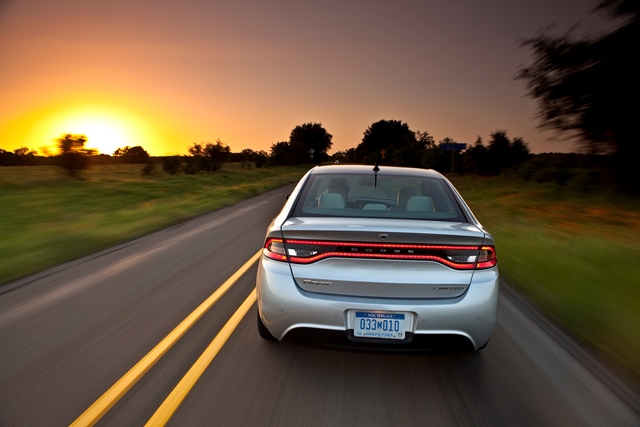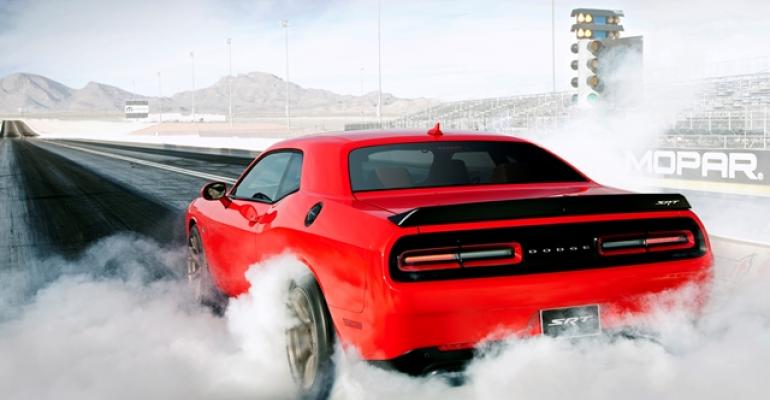CHELSEA, MI – First it was Ram, cleaved from Dodge in 2009 to become a standalone entity. Soon the storied brand will lose its Dart small-car entry and eventually its aging Caravan minivan.
So is Dodge on the road to a Plymouth-style extinction? Not so fast, says its chief cheerleader.
“Two years ago, we said we were going to purify the Dodge brand – we were going to take the best things about the Dodge brand and really amplify them,” says Tim Kuniskis, head of passenger cars-Dodge, SRT, Chrysler and Fiat, North America, during an interview here at FCA’s roundup of new products for the ’17 model year.
“The real core, the real essence, the real DNA of the Dodge brand – the things that it does best – are attitude and performance,” Kuniskis says. “And really they’re one and the same, because performance is an attitude.”
An important distinction, he notes, is that Dodge is focused on affordable mainstream performance vehicles – not the low-volume, high-priced and super-powerful niche models that typically come to mind when discussing performance cars. The SRT brand fills the premium performance part of Dodge’s portfolio with models including the 707-hp Charger/Challenger Hellcat.
“Performance cars are not all 700 horsepower,” he says, noting 65% of Chargers are sold with V-6s. “SRT becomes the halo, the ultimate performance vehicles, the extension of all the Dodges that make sense. That doesn’t mean we’re going to do an SRT Caravan. But the ones that make sense, we’re going to do an ultimate performance version.”
Kuniskis isn’t commenting on future product but confirms plans remain on track with those laid out two years ago in FCA’s 5-year plan.
For the moment, that means fewer Vipers – the halo sports car ends 25 years of production with five special editions for the ’17 model year – and more Challengers and Chargers and Durango SUVs that Kuniskis calls the core of the brand. The three nameplates accounted for 46% of Dodge’s 227,000 sales through May, with Durango up 23% year-over-year, WardsAuto data shows.
Kuniskis says that volume, along with one of the industry’s youngest demographics (the average age of a Charger buyer is 45 compared with 54 years for the sedan segment, for instance), and a lock on 44% of the muscle-car market, all bode well for the brand’s future.
“Is there a future for the brand?” he asks. “Yeah. That’s a lot of volume.”
Changes Coming for Journey, Jeep
One piece of that puzzle will change. The aging Journey CUV, though still selling strong with 37,000 deliveries through May, is not particularly well-suited for the Dodge brand, Kuniskis says.
“Do we think we need to change it at some point in the future to better align it? Absolutely.”
Production for Journey’s replacement reportedly will be relocated to Italy in 2019, where the CUV is badged the Fiat Freemont. That would free additional plant capacity in Toluca, Mexico, for production of a soon-to-be-named Jeep compact utility for sale in North America.
The so-called C-SUV goes into production in September or October in Brazil, followed by China in November or December, and finally North America at Toluca beginning in first-quarter 2017, says Michael Manley, Jeep and Ram brand chief.
Plans call for the next-generation Challenger/Charger duo to migrate to the lighter-weight, rear-drive Alfa Romeo Giulia platform in time for the ’19 model year. A Dodge-branded Barracuda on the same chassis also is rumored.
Another volume dip will come when the Caravan, still riding on the previous-generation minivan platform, ends production in the coming year. Caravan accounted for 58,000 sales through May, up 98% from 2015 as the model sells down while the all-new ’17 Chrysler Pacifica minivan ramps up. Dart’s volume, though down 39% through May, will also vanish in 2017.

A huge plus for Dodge, Kuniskis says, is being part of a larger FCA showroom featuring Ram pickups, Jeep utilities, Chrysler minivans and sedans and Fiat small cars. Dodge no longer has to cover the waterfront, but instead can focus on setting itself apart as a performance brand.
While many of the key differentiators – luxury appointments, safety features, specialized electronics – have been “democratized,” Kuniskis says, performance remains a quantifiable difference.
“We’ve already got that,” he says.
Is a brand skewed toward cars destined to fail? Kuniskis rejects that notion, at least as it relates to Dodge’s performance-car-heavy lineup. He notes that 33% of Challengers sold are premium performance models – Hellcats, SRTs or Scat Pak models.
“That is not an indication of something that is losing demand and interest in the marketplace.”
How long will it last? Kuniskis predicts a new golden age of performance, with electrification offsetting losses in pure displacement.
“At some point the big iron block will go away,” he says. “Performance won’t go away. How we get there will change.”
[email protected] @bobgritzinger





